 Kodak has today announced a new range of All-In-One Inkjet printers promising to reduce the cost of home printing by using pigment based inks and special paper.
Kodak has today announced a new range of All-In-One Inkjet printers promising to reduce the cost of home printing by using pigment based inks and special paper.
The company is claiming that their new printers will be able to output “Kodak lab-quality” photos at home using premium, pigment-based inks for up to half the price of their competitors.
Boldly claiming that their new range will change the inkjet market forever, Kodak boss Antonio M. Perez insists that his company is, “changing the rules in this industry,” giving consumers, “the freedom to print documents and photos frequently, easily and affordably with exceptional quality that lasts a lifetime under typical home display conditions.”
(We can’t help notice the king size caveat about, “typical home display conditions” contained therein. What on earth are they, we wonder?!).
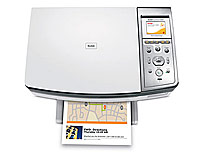 Kodak’s new range starts at $150, with the top of the range 5500 model offering a scanner, document feeder, fax and LCD display for $300.
Kodak’s new range starts at $150, with the top of the range 5500 model offering a scanner, document feeder, fax and LCD display for $300.
The inks will cost $15 for the colour cartridge (good for over 100 4×6 prints) and $10 for the black cartridge (which keeps on rocking for 300 pages).
The Kodak Easyshare range
The Kodak Easyshare 5100 All-in-One Printer ($150), offers print, scan and copy capabilities, and can print and copy up to 32 pages per minute in black and 22 pages per minute in colour
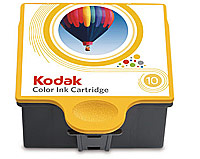 Based on the same specs as the 5100, the Kodak Easyshare 5300 All-in-One Printer ($200) bolts on a 3-inch colour LCD display and memory card slots for direct photo printing.
Based on the same specs as the 5100, the Kodak Easyshare 5300 All-in-One Printer ($200) bolts on a 3-inch colour LCD display and memory card slots for direct photo printing.
The top of the range Kodak Easyshare 5500 All-in-One Printer ($300) ramps up the feature set, offering all the features of the 5300, plus fax functionality, a 2.4-inch colour LCD display, an automatic document feeder and a duplexer attachment.
The printers will start to appear in US stores from March onwards, with the 5500 shipping in May 2007.
 Media giants Viacom International have finally lost patience with YouTube and demanded that they remove more than 100,000 of their video clips that have been posted up without permission.
Media giants Viacom International have finally lost patience with YouTube and demanded that they remove more than 100,000 of their video clips that have been posted up without permission. In a statement, a clearly miffed Viacom said: “Virtually every other distributor has acknowledged the fair value of entertainment content and has taken deliberate steps to concluding agreements with content providers.”
In a statement, a clearly miffed Viacom said: “Virtually every other distributor has acknowledged the fair value of entertainment content and has taken deliberate steps to concluding agreements with content providers.” Removing Viacom’s rich portfolio of popular clips may certainly result in loss of revenue for YouTube, but some media analysts reckon it could be a lose-lose situation all round, as both parties risk naffing off consumers.
Removing Viacom’s rich portfolio of popular clips may certainly result in loss of revenue for YouTube, but some media analysts reckon it could be a lose-lose situation all round, as both parties risk naffing off consumers. Apple has warned Windows-based iTunes users to hold back from upgrading to Microsoft Vista, because the software may not work properly with their iPods.
Apple has warned Windows-based iTunes users to hold back from upgrading to Microsoft Vista, because the software may not work properly with their iPods.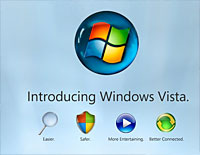 The problems included poor animation speeds, an inability to play back music and video purchased from the iTunes store and data in media, contacts and calendars not synchronising.
The problems included poor animation speeds, an inability to play back music and video purchased from the iTunes store and data in media, contacts and calendars not synchronising. High speed mobile phones and new gadgets are set to send revenue from mobile entertainment services soaring over the next five years, according to market research firm Informa Telecoms & Media.
High speed mobile phones and new gadgets are set to send revenue from mobile entertainment services soaring over the next five years, according to market research firm Informa Telecoms & Media. “Advanced mobile content and services have been slow to take off, but this should not be confused with the deepening relationship that we have with our mobile phones,” commented report author Daniel Winterbottom, senior analyst at Informa Telecoms & Media.
“Advanced mobile content and services have been slow to take off, but this should not be confused with the deepening relationship that we have with our mobile phones,” commented report author Daniel Winterbottom, senior analyst at Informa Telecoms & Media. User-generated content is also expected to grow, with Informa predicting that revenue from user-generated services will hit $13.17 billion by 2011.
User-generated content is also expected to grow, with Informa predicting that revenue from user-generated services will hit $13.17 billion by 2011. Sony Ericsson in Japan is launching the snazzy new W51S phone which comes in a striking clamshell package.
Sony Ericsson in Japan is launching the snazzy new W51S phone which comes in a striking clamshell package. The Organic Light Emitting Device (OLED) icons look rather dandy to our weary eyes, although work-shirkers probably won’t like not being able to see who’s actually calling before flipping open the phone and getting an irate boss on the line.
The Organic Light Emitting Device (OLED) icons look rather dandy to our weary eyes, although work-shirkers probably won’t like not being able to see who’s actually calling before flipping open the phone and getting an irate boss on the line. The W51S measures up at 105 × 48 × 19.3 mm, with talk time quoted at 210 minutes, with a standby time of 270 hours. For the security conscious, there’s also a feature letting users remotely lock and delete data on the handset over the web (Palm Treo users have been able to do this for years via excellent software like
The W51S measures up at 105 × 48 × 19.3 mm, with talk time quoted at 210 minutes, with a standby time of 270 hours. For the security conscious, there’s also a feature letting users remotely lock and delete data on the handset over the web (Palm Treo users have been able to do this for years via excellent software like  Are you always late for work? Does your alarm clock fail to wake you up in the morning? Have you developed a reflex action that bashes the ‘alarm off’ button while you carry on counting sheep?
Are you always late for work? Does your alarm clock fail to wake you up in the morning? Have you developed a reflex action that bashes the ‘alarm off’ button while you carry on counting sheep? When it’s time for you to get out of your jimjams, this totally daft clock launches a flying propeller that hovers around the room, making strange buzzing noises while the clock’s alarm sounds.
When it’s time for you to get out of your jimjams, this totally daft clock launches a flying propeller that hovers around the room, making strange buzzing noises while the clock’s alarm sounds. Electronics giant PC World has announced that it is to stop selling floppy disks once the current stocks run out.
Electronics giant PC World has announced that it is to stop selling floppy disks once the current stocks run out.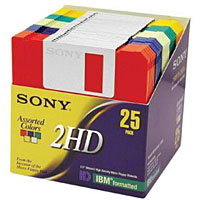 In decline since the late 1990s, the floppy once ruled supreme, shifting more than two billion units in 1998 – a figure now down to a measly 700 million last year.
In decline since the late 1990s, the floppy once ruled supreme, shifting more than two billion units in 1998 – a figure now down to a measly 700 million last year. Casio has knocked out two additions to its pocket pleasing, ultra-slim Exilim Zoom range in the shape of the 10.1-megapixel EX-Z1050 and the 7.2 million pixel Exilim Zoom EX-Z75 cameras.
Casio has knocked out two additions to its pocket pleasing, ultra-slim Exilim Zoom range in the shape of the 10.1-megapixel EX-Z1050 and the 7.2 million pixel Exilim Zoom EX-Z75 cameras. Onboard there’s Casio’s EXILIM Engine 2.0 offering new motion analysis technology, with the camera able to rattle off a claimed 7 shots per second until the memory tank hits full.
Onboard there’s Casio’s EXILIM Engine 2.0 offering new motion analysis technology, with the camera able to rattle off a claimed 7 shots per second until the memory tank hits full.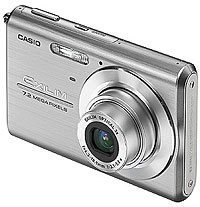 EXILIM Zoom EX-Z75
EXILIM Zoom EX-Z75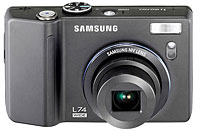 Hot off the factory presses are three new all-black models, all with distinctive and stylish looks.
Hot off the factory presses are three new all-black models, all with distinctive and stylish looks.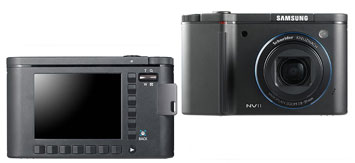
 The i7 packs a 7.2 megapixel sensor, 3x optical zoom, Advanced Shake Reduction (ASR) technology, SVGA video, face recognition ISO 1600 and even an integrated MP3 player with simulated SRS 3D sound.
The i7 packs a 7.2 megapixel sensor, 3x optical zoom, Advanced Shake Reduction (ASR) technology, SVGA video, face recognition ISO 1600 and even an integrated MP3 player with simulated SRS 3D sound. Mobile phone users are increasingly getting jiggy with the wee buttons on their handset as new figures show mobile Internet access soaring.
Mobile phone users are increasingly getting jiggy with the wee buttons on their handset as new figures show mobile Internet access soaring. Although the figures suggest we’re rapidly turning into perma-connected, perambulating Internet fiends, Thomas Husson, a mobile analyst at Jupiter Research was quick to suggest that much of the recent increase could be down to Christmas gift-giving.
Although the figures suggest we’re rapidly turning into perma-connected, perambulating Internet fiends, Thomas Husson, a mobile analyst at Jupiter Research was quick to suggest that much of the recent increase could be down to Christmas gift-giving. “The continued advancement of handsets means people are beginning to spend more time familiarising themselves with new services,” Lane added.
“The continued advancement of handsets means people are beginning to spend more time familiarising themselves with new services,” Lane added.